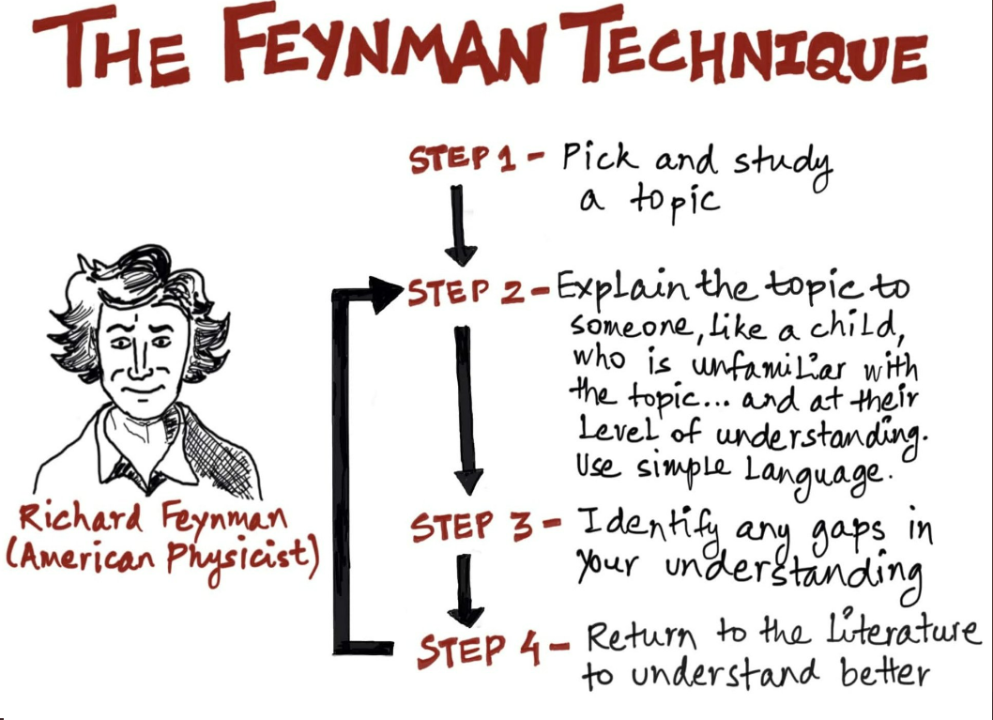In the pursuit of knowledge and mastery, we often find ourselves overwhelmed by complexity. Whether it’s learning a new skill, understanding a difficult concept, or mastering a subject, the journey can seem daunting. However, amidst this complexity lies a simple yet profoundly effective method: the Feynman Technique. Named after the renowned physicist Richard Feynman, this technique offers a structured approach to learning that emphasizes simplicity, clarity, and deep understanding. In this article, we’ll delve into the essence of the Feynman Technique, explore its principles, and uncover how it can unlock the doors to mastery in any field.
Understanding the Feynman Technique
At its core, the Feynman Technique revolves around the concept of teaching. Richard Feynman, known for his exceptional ability to convey complex ideas in simple terms, believed that the true test of understanding lay in one’s capacity to explain a concept to someone else. The technique encompasses four key steps:
- Choose a Concept: Select a topic or concept that you want to understand deeply. It could be anything from a mathematical theorem to a historical event or a programming language.
- Teach it to a Child: Pretend you’re explaining the concept to a young child with no prior knowledge of the subject. Use simple language, avoid jargon, and focus on breaking down complex ideas into bite-sized, understandable chunks.
- Identify Knowledge Gaps: As you attempt to teach the concept, pay attention to areas where you struggle to explain or encounter gaps in your understanding. These are the areas that require further clarification and study.
- Review and Simplify: Return to the source material to fill in the gaps in your understanding. Break down complex ideas into simpler components, and use analogies, examples, and visual aids to reinforce your comprehension.
The Power of Simplicity
What sets the Feynman Technique apart is its emphasis on simplicity. In a world inundated with information, simplicity is often undervalued, yet it holds the key to effective learning. By distilling complex ideas into their simplest form, the Feynman Technique fosters a deeper understanding that transcends surface-level memorization.
Moreover, simplicity enhances retention. When we grasp a concept in its simplest form, it becomes more memorable and easier to recall. Just as a well-crafted story sticks in our minds long after we’ve heard it, a concept presented with simplicity leaves a lasting imprint on our memory.
Applying the Feynman Technique
The beauty of the Feynman Technique lies in its universality. It can be applied to virtually any subject or skill, from mathematics and science to history, literature, and beyond. Whether you’re studying for an exam, learning a new language, or seeking to understand complex phenomena, the Feynman Technique offers a roadmap to mastery.
Let’s consider a practical example: learning a new programming language. Suppose you’re trying to grasp the concept of object-oriented programming (OOP). Using the Feynman Technique, you might proceed as follows:
- Choose a Concept: Select the fundamental principles of OOP, such as encapsulation, inheritance, and polymorphism.
- Teach it to a Child: Imagine explaining OOP to a young child who has never heard of programming. You might use analogies like comparing objects to Lego blocks or explaining inheritance as passing down traits from parents to children.
- Identify Knowledge Gaps: As you simplify the concepts, you may realize that your understanding of encapsulation is fuzzy. You make a note to revisit this aspect and delve deeper into how it works in practice.
- Review and Simplify: Return to your learning resources, such as textbooks or online tutorials, to gain a clearer understanding of encapsulation. Break down code examples, seek clarification from experts, and reinforce your understanding through practical exercises.
Advantages of the Feynman Technique
The Feynman Technique offers several distinct advantages over traditional methods of learning:
- Deep Understanding: By teaching a concept in simple terms, you solidify your own understanding and uncover gaps in knowledge that require further exploration.
- Retention and Recall: Simplifying complex ideas enhances retention and makes them easier to recall when needed.
- Clarity and Communication: The ability to explain complex concepts in simple terms improves communication skills and fosters clarity of thought.
- Iterative Learning: The Feynman Technique is an iterative process, allowing you to revisit and refine your understanding over time.
- Universal Applicability: Whether you’re a student, a professional, or an autodidact, the Feynman Technique can be applied to any subject or skill.
Overcoming Challenges
While the Feynman Technique is a powerful tool for learning, it’s not without its challenges. One common hurdle is the temptation to revert to complexity. As humans, we often equate sophistication with intelligence, leading us to overcomplicate explanations unnecessarily. To overcome this challenge, it’s essential to cultivate a mindset of simplicity and clarity, focusing on conveying ideas in the most straightforward manner possible.
Another challenge is the fear of exposing gaps in knowledge. When attempting to teach a concept, we may encounter areas where our understanding is lacking or incomplete. Instead of viewing this as a setback, embrace it as an opportunity for growth. Recognizing and addressing knowledge gaps is an integral part of the learning process, ultimately leading to a deeper and more robust understanding.
Conclusion
In a world inundated with complexity, the Feynman Technique serves as a beacon of simplicity and clarity. By embracing the principles of teaching, simplicity, and iteration, we can unlock the doors to mastery in any field. Whether you’re a student embarking on a learning journey or a seasoned professional seeking to deepen your expertise, the Feynman Technique offers a timeless approach to understanding that transcends boundaries and empowers lifelong learning. So, dare to simplify, embrace the power of teaching, and embark on a journey of discovery with the Feynman Technique as your guide.




